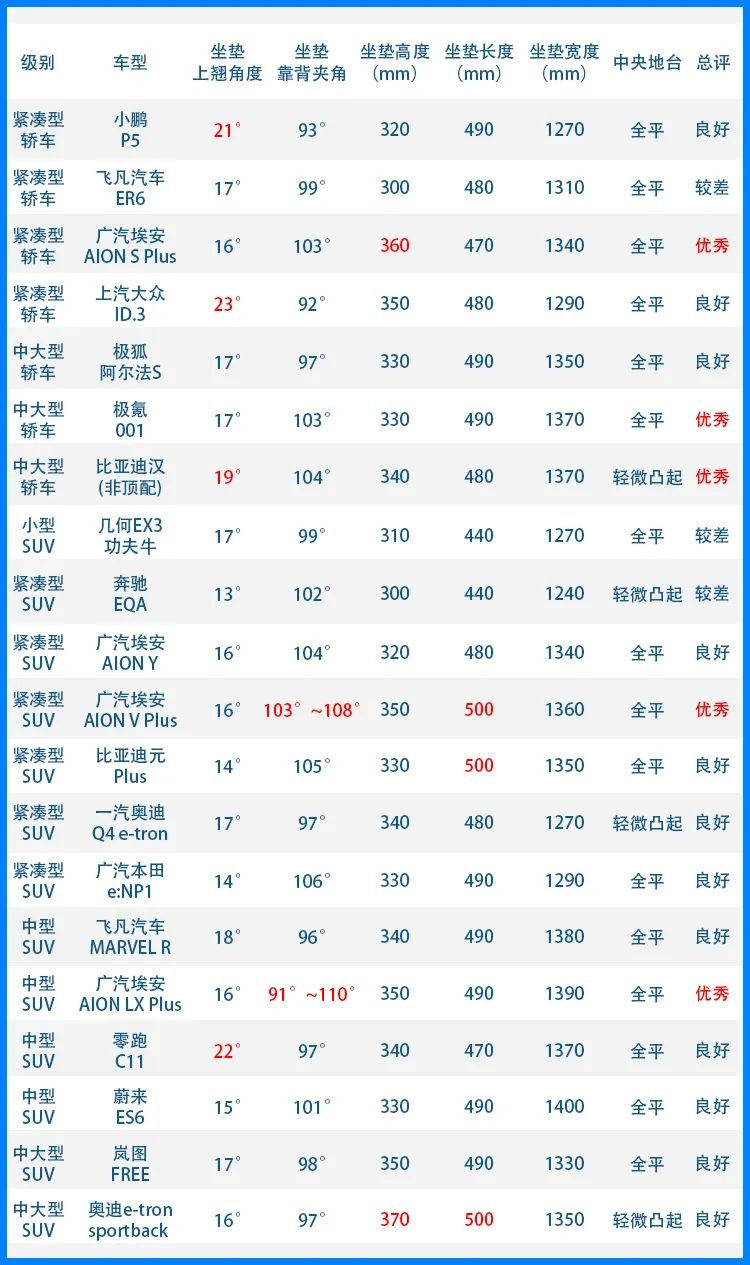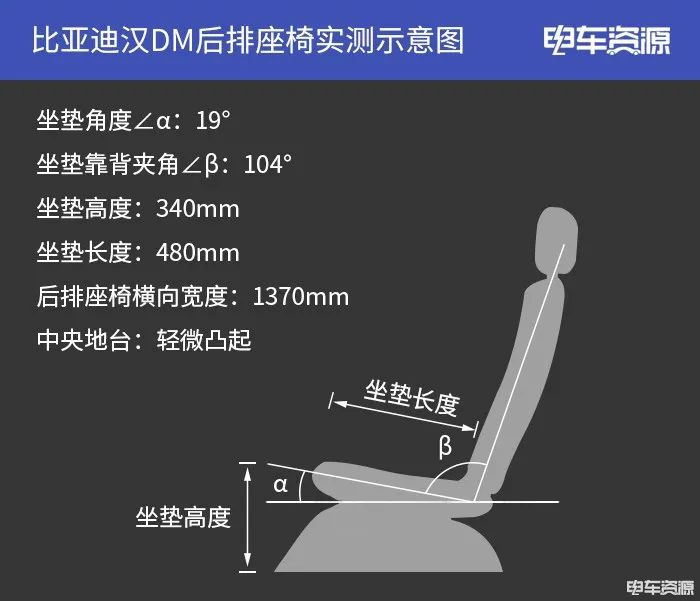Author: Master
Foreword: For most consumers who buy four-door car models, the space and comfort of the rear seats are definitely important parts that need to be understood. In terms of space, we can directly let the experiencer sit on the seat for demonstration. Although the driving posture, height, and weight of different people are different, it can already provide a more intuitive reference.

However, not only space affects the comfort of the rear seats, but the size and angle performance of the seats themselves are also equally important. In order to quantify the comparison more clearly, in addition to using a tape measure to measure the length and height of the rear seat cushions, we will also introduce an angle gauge to measure the upturned angle of the cushion and the stretching angle of the backrest.
First, let’s understand what is the “little stool” phenomenon?
In the era of fuel-powered cars, we often use this term in the third row of 7-seat SUVs, which means that the seat is too low and does not support the body well, just like sitting on a little stool, the thighs have no support, and the backrest is not tilted enough. It is better than nothing.
In the new energy vehicles, due to the battery pack arranged in the chassis invading part of the interior space, many cars also have the phenomenon of sitting on a “little stool”. The phenomenon is more obvious in low and short sedans.

For example, the Tesla Model 3, which is basically benchmarked by all new energy vehicles, is restricted by the sleek car design and has a thick battery pack on the chassis. Its rear seat has a more obvious “little stool” phenomenon. The overall height of the cushion is low, and the backrest is not extended enough, resulting in a poor experience in the rear seat.

Similarly, as a Tesla, although the Model Y has the same battery pack, it is larger in overall size and higher in the body, so the rear seat experience is obviously more comfortable, but we can still see that its cushion length is short and cannot fully support the thighs.
It is worth mentioning that the “little stool” phenomenon of new energy vehicles is not directly related to whether the model is a “gas-to-electric” one, for example, the Model 3 in the above pictures is a pure electric platform. And the Geometry C, which is “gas-to-electric”, has a relatively good spatial layout and design, so it can also achieve a good riding experience.

With the advancement of battery technology, the thickness of future battery packs will become smaller and smaller, and I believe that this “little stool” phenomenon will gradually improve in the future.## Measurement of Rear Seats of 20 New Energy Vehicles at Guangzhou Auto Show
At the previous Guangzhou Auto Show, we measured the rear seats of 20 popular new energy vehicles and some upcoming new vehicles, covering multiple levels and positions. Let’s take a look together:

Based on the measurement results and actual test riding experience, we can discover some rules for the comfort of rear seats:
The Angle of the Cushion Should Be At Least 15° Upward

In this rear seat experience, the performance of the Mercedes-Benz EQA was relatively poor. The angle of the cushion was not large enough, and the length was also short. After arranging the battery pack, the entire floor was raised, further compressing the cushion height, resulting in no support for the thighs and a “small stool” phenomenon similar to the third row of many 7-seat SUVs.
The Larger the Angle Between the Cushion and the Backrest, the Better
The angle between the cushion and the backrest is easy to understand. Assuming the cushion is horizontal, the larger the angle of the backrest, the more comfortable the stretch between the legs and the upper body. When it reaches 180°, it is equivalent to a flat bed.

For example, the Xpeng P5 has a 17° upward cushion and a 104° angle between the cushion and the backrest, with excellent cushion length and height, so it can naturally obtain excellent rear comfort.
However, we need to pay attention that since the cushion itself is not horizontal, we cannot simply judge the comfort based on the angle between the cushion and the backrest.

For example, although the angle between the cushion and the backrest of the Volkswagen ID.3 is only 92°, the cushion itself has an upward angle of up to 23°. Therefore, the backrest is actually at a sufficient reclining angle compared to the horizontal surface. In addition to the longer cushion and sufficient height, the support for the thighs is good, and the overall comfort is also good.
Compared with Cushion Length, Cushion Height Has a Greater Impact on Comfort
In this regard, the previously tested GAC Aion S Plus is a good example.“`

While its 470mm seat cushion length is not particularly outstanding, the seat cushion height can reach 360mm. Combined with a moderate seat-up angle and backrest angle, the Aion S Plus has outstanding comfort among its peers.

A counterexample here is FAW’s ER6. Although its seat cushion length reaches 480mm, the height is only 300mm, causing the whole thigh to be suspended in the air. The main reason is that the 70 kWh battery greatly raises the interior floor and even has a considerable impact on the driving posture of the front seat.
Models that are compatible with both fuel and electric vehicles are not necessarily inferior
As mentioned earlier, the “small bench” phenomenon of new energy vehicles is not directly related to whether the vehicle type is “oil-to-electric”. So what about some models that are compatible with both fuel and electric vehicles?

Currently, most of BYD’s models have this structural form, such as the BYD Han, which broke the 10,000 unit sales mark last month.

After our actual test, all indicators of the rear seat of the BYD Han are relatively excellent, providing a pretty good riding experience. Even in non-top configuration models with unadjustable rear seats, the large seat-up angle and backrest angle have formed a semi-reclining sitting posture.
Even though there is a slight bump on the central floor, among all the tested models this time, the rear-seat comfort of BYD Han is still the best.
Final Remarks
We do not deny the limitations of such tests, such as our inability to quantify indicators such as the softness of the seat itself, and there is inevitably some error due to manual measurement. Also, the evaluation is based on the author’s personal subjective experience (height 174cm), so the data is for reference only. But we try our best to ensure that the same method is used for the test of all models, so there is still some significance in horizontal comparison.
Overall, the height and body size of each driver and passenger are different, so it is important to experience it personally to see if it suits you.
This article is a translation by ChatGPT of a Chinese report from 42HOW. If you have any questions about it, please email bd@42how.com.
